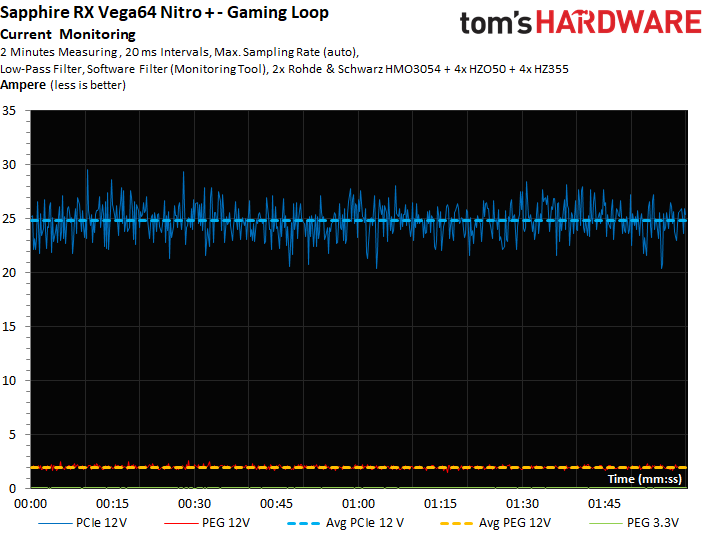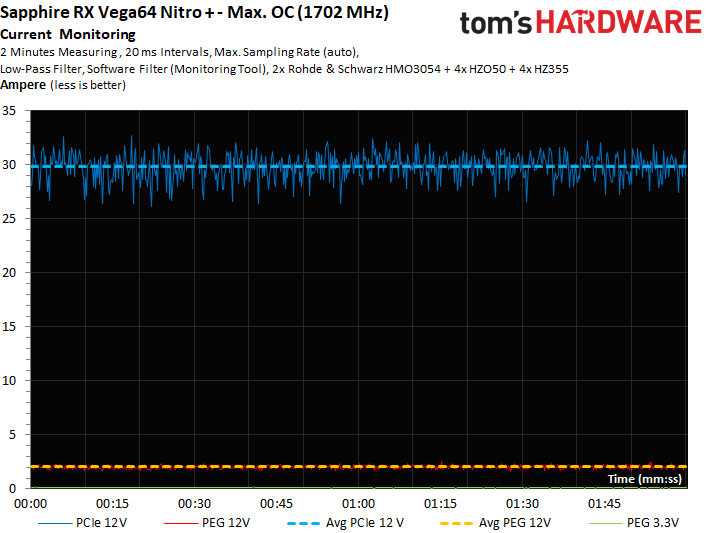Sapphire Radeon RX Vega 64 Nitro+ Review
Why you can trust Tom's Hardware
Power Consumption
Power Consumption at Different Loads
Power consumption in our gaming loop lands around ~327W, which is a significant step up from the 300W mark, and well above the reference model’s measurements. In return, though, the Radeon RX Vega 64 Nitro+ provides consistent performance accompanied by an acceptable noise level. Part of a card’s performance is based on its power consumption, after all, and Sapphire can’t do anything about Vega 10's inherent architecture. The company is left with cooling, voltage, and power limits in order to tune this card's behavior.
The corresponding voltages for our gaming loop and stress test at Sapphire's stock settings are plotted in the following graph:
Load on the Motherboard Slot
PCI-SIG specifies a maximum of 5.5A (66W) for the motherboard’s 12V rail. Sapphire's Radeon RX Vega 64 Nitro+ doesn’t even hit half of that number with its 2.7A peak during our stress test. The gaming benchmark is even better-looking with a 2A measurement, and the same goes for our maximum overclock. The power connector load distribution is perfectly balanced, and the motherboard slot doesn't come anywhere near being stressed by the load it shoulders.
Power Consumption In Detail
The graphs below plot detailed power consumption and current readings in order to better illustrate our findings. Naturally, gaming yields the highest peaks, registering up to 388W. That's nothing to worry about, though: the spike is far too brief to cause a problem.
The same goes for the corresponding current measurements:
Maxing out the power limit in software results in an average power consumption increase of ~60W, which is reflected in our data. Peaks as high as 421W are easily handled by modern power supplies. But it's still good to know they're there. Just make sure you buy high-quality equipment before piecing together an aggressive gaming PC.
The current can spike as high as 33A, meaning the third eight-pin PCIe power connector isn't really necessary. Without it, the specifications would have only been exceeded slightly, if at all.
Get Tom's Hardware's best news and in-depth reviews, straight to your inbox.
The stress test registers lower peaks, but a higher average, than our gaming benchmark.
The current follows suit without any anomalies to report.
MORE: Best Graphics Cards
MORE: Desktop GPU Performance Hierarchy Table
MORE: All Graphics Content
Current page: Power Consumption
Prev Page Results: Metro, Middle-earth & The Witcher 3 Next Page Overclocking, Frequency, Temperature & Noise
Igor Wallossek wrote a wide variety of hardware articles for Tom's Hardware, with a strong focus on technical analysis and in-depth reviews. His contributions have spanned a broad spectrum of PC components, including GPUs, CPUs, workstations, and PC builds. His insightful articles provide readers with detailed knowledge to make informed decisions in the ever-evolving tech landscape
-
AgentLozen Even though Vega 64 is rough around the edges, I appreciate that you gave the Sapphire Nitro an Editor's Choice award for it's technical prowess.Reply
There is so much hardware out there with cut corners that it's nice to see something work so well. -
FormatC ReplyWhat mosfets is sapphire using for VDDC
Plase take a look at page Two. You will get the full info, pictures included. ;)
I wrote on page Two:
...This so-called doubling is achieved through a total of seven IR3598s located on the back of the board. Voltage conversion for the 14 circuits is handled by one IRF6811 (on the high side) and one IRF6894 (on the low-side) for each circuit. The latter also include the necessary Schottky diode.
-
docswag Reply20485887 said:What mosfets is sapphire using for VDDC
Plase take a look at page Two. You will get the full info, pictures included. ;)
I wrote on page Two:
...This so-called doubling is achieved through a total of seven IR3598s located on the back of the board. Voltage conversion for the 14 circuits is handled by one IRF6811 (on the high side) and one IRF6894 (on the low-side) for each circuit. The latter also include the necessary Schottky diode.
My bad, I must have skimmed over that part. Thanks! -
Cryio So once the drivers will actually apply to 3rd party OEMs as well given the reference with slower clocks is sometimes faster, will basically make Vega64 universally and sometimes significantly faster than the 1080 and guaranteed substantially faster in DX12/Vulkan games.Reply
So ... with some underclocking and undervolting, this should perform on the level of the 1080 while being more future proof. Got it.
Wonderful work AMD! Too bad miners skyrocketed the price. -
Wisecracker Thanks for the bench work. Interesting boost in minimums in some titles considering struggles with 'optimizations'Reply
What's the verdict on the previously reported 'elevation difference' between the memory stacks and processor?
-
FormatC This is randomly the molded version. That means, no difference. :)Reply
Powercolor got unmolded and the result is well-known. But I also know from others, that Sapphire is using also both packages. The 3rd package version is Vega56 only. -
FormatC It depends at your preferences, what you need in your rig. Only the price is currently a big con. Too bad.Reply








